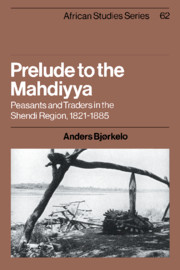Book contents
- Frontmatter
- Contents
- Figures
- List of maps
- List of tables
- Preface
- Acknowledgements
- Abbreviations
- Weights and measures
- The Sudan in the nineteenth century
- Introduction
- 1 The Ja'alī Kingdom of Shendi and its destruction
- 2 Shendi's economy on the eve of the Turkiyya
- 3 The Ja'aliyyīn under Turkish administration
- 4 The transformation of agriculture
- 5 Taxation
- 6 The transformation of commerce
- 7 Conclusion: dispersion and return
- Appendix: Three contracts from the archive of 'Abd Allāh Bey Ḥamza
- Notes
- Sources and bibliography
- Index
- OTHER BOOKS IN THE SERIES
4 - The transformation of agriculture
Published online by Cambridge University Press: 31 October 2009
- Frontmatter
- Contents
- Figures
- List of maps
- List of tables
- Preface
- Acknowledgements
- Abbreviations
- Weights and measures
- The Sudan in the nineteenth century
- Introduction
- 1 The Ja'alī Kingdom of Shendi and its destruction
- 2 Shendi's economy on the eve of the Turkiyya
- 3 The Ja'aliyyīn under Turkish administration
- 4 The transformation of agriculture
- 5 Taxation
- 6 The transformation of commerce
- 7 Conclusion: dispersion and return
- Appendix: Three contracts from the archive of 'Abd Allāh Bey Ḥamza
- Notes
- Sources and bibliography
- Index
- OTHER BOOKS IN THE SERIES
Summary
THE LOCAL SETTING
The Ja'aliyyin gained their livelihood principally from river bank cultivation, with the addition of rainfed desert ('a⃛mūr) cultivation and animal husbandry. They practised a subsistence economy with durra as the staple crop. Small-scale marketing of farm produce and handicrafts through barter went largely towards supplementing the household economy. The subsistence character of the economy was subjected to serious attack during the Turkiyya, but did not change greatly before the introduction of mechanical pump schemes in the present century. Trade was regarded as an activity which under the right circumstances could secure a better and less arduous way of living than cultivation, and the Ja'aliyyīn are often stereotyped as traders. This conceals the fact that they are and have always been largely riverain peasants.
Those who deserted cultivation for a short period or for ever, resorted to the institution of amdna, ‘trust’, and arranged for their land to be cultivated by others (family members or trustworthy neighbours) and seldom considered selling it. Rather, capital accumulated in trade would in part be invested in water-wheels and more land either back home or in the diaspora. Emigrants continued therefore to keep an eye on their patrimony, lest it should be appropriated by others or sold by family members. Emigrants were still members in absentia of the village society, enjoying the same rights and duties as the resident villagers, with obligations to aid relatives and neighbours, to give presents at the various rites depassage such as circumcision, and to marry their cousins.
- Type
- Chapter
- Information
- Prelude to the MahdiyyaPeasants and Traders in the Shendi Region, 1821–1885, pp. 53 - 81Publisher: Cambridge University PressPrint publication year: 1989

